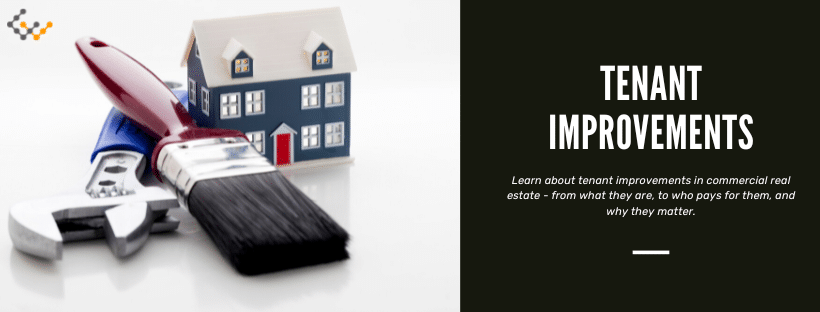Tenant Improvements in Commercial Real Estate

Tenant improvements affect property value, tenant satisfaction, leasing terms, insurance coverage (for the tenant), and more. If you’re involved in commercial real estate in any way, it’s essential that you understand what qualifies as leasehold improvements and what doesn’t. Here’s a look at what tenant improvements are, and the corresponding implications.
What Exactly is a Tenant Improvement?
A tenant improvement, also known as a leasehold improvement, is a modification or alteration that’s made to a commercial rental space in order to meet the tenant’s specific needs. The improvement enhances the space’s functionality for the tenant.
Broadly speaking, upgrades that aren’t specifically tailored for a tenant’s needs usually aren’t considered tenant improvements.
What’s a Tenant Improvement Allowance?
Tenant improvement allowances are a common feature of many commercial leases. The landlord provides funds to cover some or all of a tenant’s improvement costs. The landlord might go ahead and make the improvements themselves, or they might reimburse the tenant for making the improvements.
The amount of a tenant allowance depends on factors such as property location, space desirability, tenant desirability, tenant creditworthiness, lease term, and other details. Landlords may offer a flat amount as a tenant improvement allowance, or a calculated amount that reimburses tenant improvement costs per square foot.
What Qualifies as a Leasehold Improvement?
Most changes that are specific to a tenant’s needs and made to a tenant’s space qualify as a leasehold improvement. Improvements might include adding walls, installing new flooring, upgrading light fixtures, or redesigning a leased space’s floor plan. The following are some tenant improvement examples:
- Partitioning the leased space with new walls in order to change the layout
- Installing new flooring, ceiling or lighting fixtures to improve the space’s aesthetic
- Adding or modifying signage inside and outside of the building
- Improving a security system to meet a particular client’s safety needs
- Improving the HVAC system to meet a particular client’s air quality needs
- Adding accessibility features so a client’s leased space is ADA compliant
- Installing specialized equipment or machinery that’s necessary for the tenant
In the case of a security system, only hardware that’s needed to boost security would likely be considered a tenant improvement. Hiring a service that provides security guards or subscribing to a remote service wouldn’t be a tenant improvement, since it doesn’t actually modify the leased space. Also, the hardware upgrade might only count if it was done to meet a tenant’s particular needs (see the HVAC example below).
What Doesn’t Qualify as Leasehold Improvement?
Not all changes made to a commercial rental space qualify as leasehold improvements, even if they’re made when a tenant moves in. Some types of modifications that normally aren’t considered leasehold improvements include:
- Structural changes or additions that affect the building’s core framework
- Routine maintenance and repairs that are needed or have been neglected
- Upgrades made as part of the landlord’s overall property investment plan
- Upgrades to common areas or shared facilities that benefit all
Investment plan upgrades might include redoing all windows, upgrading the entire building’s HVAC system, adding an electronic directory, etc. Common areas and shared facilities include spaces like common restrooms, parking lots, lobbies and entryways, etc.
HVAC Systems as an Example
Where some items may or may not be considered leasehold upgrades, the HVAC system serves as a good example.
A new HVAC system is unlikely to be a leasehold upgrade if it’s made to the entire building’s system, or if each leased space’s system is being upgraded according to a building-wide plan. Installing a new HVAC system for just a specific leased space is also unlikely to be a leasehold upgrade if it’s done just to make the space generally more desirable to tenants.
Should a medical tenant move in, however, upgrading the HVAC system could be a leasehold upgrade. If a specialized system must be installed in order to meet the medical tenant’s air filtration and air quality needs, then that’s an improvement that makes the leased space better suited for a specific tenant’s needs.
Similar considerations would be used to decide whether a security system or similar upgrade was a tenant improvement.
Who Owns Tenant Improvement?
Typically, tenant improvements become the property owner’s assets once completed. Since these improvements are attached to the commercial space, they cannot be removed or relocated by the tenant when the lease ends.
However, specific lease terms may permit the tenant to remove certain improvements, such as trade fixtures or personal property. Leases may also occasionally grant the tenant ownership so that the tenant becomes responsible for insuring any build-out.
It’s crucial for both parties to discuss and agree upon the ownership and disposition of tenant improvements in the lease agreement. These should be noted just as any other important details need to be.
Are Tenant Improvements Capital Expenses?
Tenant improvements are generally considered capital expenses as they increase the property’s overall value and extend its useful life.
Capital expenses are typically depreciated over the asset’s useful life, which is 39 years for non-residential property in the United States. Shorter depreciation periods may apply to certain leasehold improvements, or when the lease term is shorter than the standard useful life.
Tax Implications for Tenant Improvement
The tax implications for tenant improvements can be complex and vary depending on factors like the ownership structure, lease terms, and the improvements’ nature. Some key tax considerations include:
- Depreciation: Tenant improvements are usually depreciated over 39 years. Landlords that pay for improvements might also use shorter periods in certain situations. Tenants may be able to claim depreciation deductions if they bear the improvement costs.
- Tax Deductions: Tenants can generally deduct tenant improvement costs per square foot as a business expense if the landlord does not reimburse them. However, if the landlord provides a tenant improvement allowance, the tenant may have to amortize the allowance over the lease term.
- Section 179 Expensing: Some leasehold improvements may qualify for Section 179 expensing, allowing the tenant to deduct the entire improvement cost in the year it was incurred. This provision is subject to specific eligibility criteria and annual limits.
Tenants and landlords should consult a qualified tax professional when negotiating a lease so that any leasehold improvements being made can be structured for the maximum tax advantage.
Wrapping Things Up
Tenant improvements are a significant part of almost every commercial real estate lease. Make sure you know what counts as leasehold improvements and what doesn’t, along with the ownership, capital expense implications, and tax considerations of them.

